Exploring The Box Art Gallery of The Legend of Zelda
Intro
When one thinks about The Legend of Zelda, images of gallant heroes, fantastical realms, and epic quests come to mind. Yet, behind this rich tapestry of gameplay lies a gateway that many fans may not fully appreciate: the box art. It’s not just a piece of cardboard artfully painted; it acts as a vibrant storyteller—a visual prologue to the adventures that await inside. In this exploration, we journey through the box art gallery of the series, tracing how each cover encapsulates not just the game’s mechanics, but its spirit and evolution.
As a game series that spans over three decades, the visual representation of The Legend of Zelda has morphed with changing times, mirroring shifts in art styles, marketing, and cultural narratives. Through a meticulous examination, we unravel the significance of these art pieces, understanding how they serve both as marketing tools to lure players in and as extensions of the immersive experiences that fans treasure.
Understanding the Significance
The box art is where artistry meets strategy. It must strike a balance between being visually stunning while conveying enough details to spark interest. For instance, the iconic image of Link, often brandishing his sword in a dynamic stance, is not simply to catch the eye. It’s a portrayal of heroism, destined to evoke feelings of bravery and adventure that the game seeks to deliver.
Moreover, the evolution of box art speaks volumes about the shifting narrative techniques within the games themselves. Each illustration stands as a period piece, reflecting the trends and expectations of its time, making them worthy of scrutiny.
The Objective of This Exploration
Our focus will not just linger on how to appreciate these designs but delve into the myriad ways they enrich the Zelda lore for discerning fans. We will dissect specific artworks, trace their historical significance, and connect them to the broader cultural phenomena surrounding gaming.
As we meander through this artistic journey, expect to uncover the layers of meaning tucked away within the graphics, inspire your next gaming session, or perhaps even rekindle lost memories of adventures past. The box art of The Legend of Zelda is more than just a cover; it’s a doorway into the heart of an enduring legacy, one that continues to enchant gamers old and new.
Preface to Box Art in Gaming
The advent of box art in the gaming industry serves not only as a protective shell for the game but also as a vital gateway into the gaming experience itself. For many players, the first encounter with a video game occurs not through gameplay but through the visual representation on its cover. In the case of The Legend of Zelda series, the artistry on the box has played an indispensable role in conveying the essence of the game long before the player even holds the controller.
The Role of Box Art
Box art is much more than decorative; it functions as a marketing tool that captures attention in a crowded marketplace. Think of it like a bright lighthouse in the fog. It is designed to entice passersby, promising an adventure within. In the world of The Legend of Zelda, the imagery on the box art often sets the stage for the epic tales that lie within, hinting at the adventures of Link, Princess Zelda, and the intricate landscapes of Hyrule. Such artistic choices play a crucial role in shaping expectations and informing potential buyers about the thematic undercurrents that they’re about to plunge into.
Moreover, through clever use of color, composition, and symbolism, box art can reflect the game's mood and genre. For instance, darker tones might suggest a more mature or serious narrative, while brighter colors often connote fantastical and light-hearted experiences. Therefore, the cover is an essential aspect of marketing, serving to crystallize the mood of the game while also aiming to forge a strong emotional connection with its audience.
Box Art as a Cultural Artifact
As consumers, we often overlook the deeper significance of items we regularly use or encounter. Box art transcends mere graphics; it embodies the culture and values of the time when it was created. The Legend of Zelda series has been active for several decades, and its cover art has evolved alongside cultural trends and technological changes. Each design encapsulates a moment in time, serving as a record of artistic trends and consumer preferences.
"Box art is not just a piece of cardboard; it’s a snapshot of the era it represents."
Visitors to a gallery showcasing Zelda's box art would not only appreciate the aesthetics but also the evolution of societal tastes. For example, the shift from hand-painted illustrations to computer-generated graphics marks a significant transition in both art and gaming technology. This metamorphosis in design reflects broader cultural shifts—from the rise of digital art forms to contemporary values such as inclusivity and narrative depth.
Thus, box art stands as a testament to both the artistic evolution in gaming and the cultural backdrop of the times, making it an invaluable artifact worthy of exploration. Its narrative function enriches the context of gameplay and aesthetic appreciation, further attracting aficionados and newcomers alike to the saga of The Legend of Zelda.
The Legend of Zelda: An Overview
The world of The Legend of Zelda is a sprawling tapestry woven with lore, adventure, and artistry that captivates fans worldwide. Delving into the heritage of this beloved franchise provides not just a historical context but an understanding of the broader impact it had on the gaming industry and culture at large. It's essential to acknowledge its influence, given that both gameplay mechanics and artistic direction have evolved throughout the years, ultimately shaping a unique identity while resonating with multiple generations.
Franchise Origins
The origins of The Legend of Zelda can be traced back to the creative vision of Shigeru Miyamoto and Takashi Tezuka, who wanted to design a game that combined the excitement of exploration with deep storytelling. Launched in 1986 on the Famicom Disk System, The Legend of Zelda was a radical departure from its contemporaries. At the time, most games were linear and confined by their limitations.
But what made the first installment remarkable was its rich and expansive land of Hyrule, inviting players to uncover secrets and navigate through dungeons at their own pace. By incorporating non-linear gameplay, players could explore in any order, creating unique adventures tailored to their choices. This shift in design philosophy resonated deeply. The box art, with its familiar golden cover, not only caught the eye in stores but encapsulated the grand sense of adventure held within the game itself.
Another key component was the introduction of gameplay mechanics like inventory management and leveling up—a notable change compared to the simpler design of many games back then. These principles of exploration and player choice planted seeds that would grow into lush landscapes in future Zelda titles.
Impact on Video Game History
Overall, the impact of The Legend of Zelda on video game history is monumental. It didn't just inspire future action-adventure games but also established standard gameplay mechanics still prevalent today. The Zelda series introduced many concepts:
- Open-world exploration: Encourage players to approach challenges in varied ways.
- Puzzle integration: Merging puzzles with combat and exploration, setting the stage for enchanting gameplay experiences.
- Rich narratives: Opening doors to a world where storytelling and gameplay coalesce seamlessly.
"Zelda’s legacy is about more than just the games; it’s about a shared experience that builds community among players."
The franchise broadened the scope of what games could achieve artistically and thematically. Different box art designs, from the first installment's golden sheen to the ethereal quality of Breath of the Wild, reflect this evolution, acting as both a marketing tool and a narrative summary. Today, the series stands as a touchstone for game developers, artists, and narrative designers alike, illustrating the potential of video games as a form of art.
The Evolution of Box Art
The evolution of box art serves as a vital lens through which one can view the progression of The Legend of Zelda series. From its inception in the mid-1980s to its current iterations, the changing designs reflect shifts not only in aesthetic preferences but also in marketing strategies and cultural expectations.
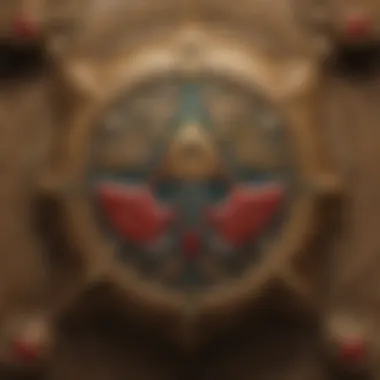
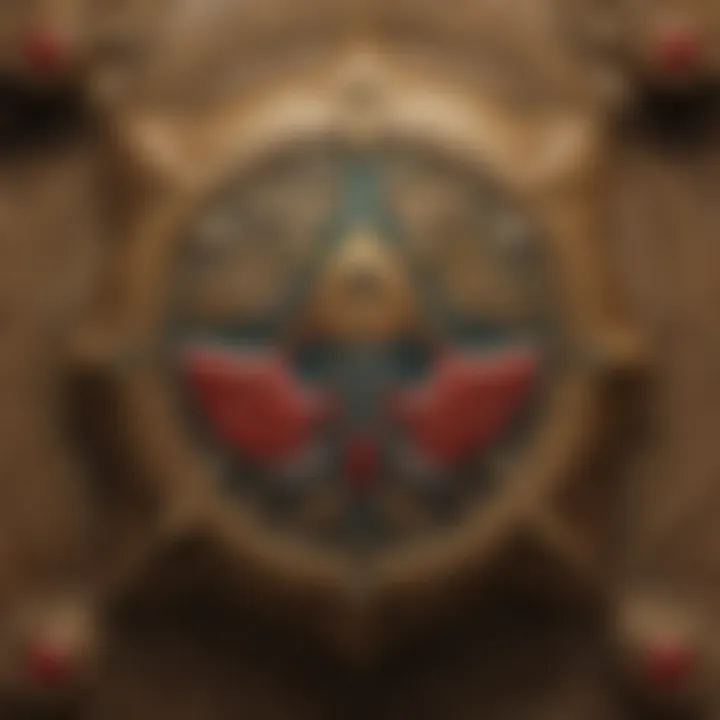
The importance of this topic lies in its dual role: box art is both an advertisement and a storytelling element. A well-crafted box can pull in a casual observer, while also speaking to the heart of long-time fans. The connection established through these artworks goes beyond mere visuals; it can generate nostalgia, excitement, and anticipation for what's inside the box.
When examining the evolution of box art in the Zelda series, one must consider:
- Artistic Styles: How artists have shifted from pixelated designs to more intricate illustrations as technology permits.
- Cultural Influences: How each game reflects the zeitgeist of its time, showcasing not just gaming trends but also societal norms.
- Marketing Strategies: The varied approaches companies take to resonate with differing audience demographics.
This analysis will reveal the deeper cultural significance of box art, illuminating how it has helped shape, and is shaped by, the franchise’s identity.
Artistic Trends Through the Years
Artistic trends within the Zelda series box art are diverse and vibrant. Each entry showcases the zeitgeist of its release, while also echoing changes in the broader artistic landscape.
Let's take a closer look:
- Early Designs (1986-1991): The original game featured a simple yet evocative design centered around the golden cartridge and its minimalist logo. The aesthetics of that time leaned heavily on fantasy themes, appealing to a sense of adventure. The accompanying illustrations often drew on medieval lore, framing Link’s quest in familiar, yet fantastical, settings.
- Emergence of 3D (1998): With Ocarina of Time, the box art offered a glimpse of a more modern aesthetic. The representation of Link not only engaged viewers but also marked a transition to 3D modeling that reflected advancements in technology. Layers of texture and color became crucial in conveying the immersive nature of this game.
- High Fantasy and Maturity (2006): As the series grew, so too did the complexity of its narratives. The cover of Twilight Princess echoed a darker tone, using deep colors and intricate designs to hint at deeper, more mature themes. This evolution in visual style mirrored the changing perceptions of the target audience, as gamers grew up with the series.
In sum, artistic trends illuminate not just the technical growth in game design but also the shifting priorities of both creators and players.
Technological Advances in Design
The advancement in technology plays a profound role in shaping box art over the years. Initially, box art for the Zelda series relied heavily on traditional illustration techniques. As the series progressed, new tools and methods revolutionized how artists approached these designs.
- Digital Artistry: As the transition from 2D to 3D occurred, artists increasingly adopted digital methods. Programs such as Adobe Photoshop allowed for layering and complex manipulations that early illustrators could only dream of. This shift opened up new avenues for creativity in character depiction and landscape styles.
- High-Resolution Imagery: With new consoles came the ability to print images in much higher qualities. Fans were no longer confined to pixelated art; instead, they could revel in vivid representations and fine details that brought the fantasy world of Hyrule to life.
- 3D Modeling: By utilizing 3D models in box design, the depiction of characters like Link became more relatable and iconic. This technique has led to box art that captures dynamic poses and expressions, allowing for a deeper connection to the character.
To summarize, the evolution of box art in the Legend of Zelda series reflects broader artistic, cultural, and technological changes in gaming and art. The artistic choices guide fans through familiar and nostalgic terrain, while innovations continuously redefine how we perceive and interact with these beloved games.
Iconic Box Art Designs
When we talk about the iconic box art of The Legend of Zelda series, we're stepping into a realm where visual storytelling meets marketing genius. This box art doesn't just grab your attention; it tells a story, invites curiosity, and serves as the gateway to a fantastical world. Each design encapsulates a moment or essence of the game, creating an emotional connection before the player even picks it up.
These designs are significant for several reasons:
- They reflect the artistic trends and technological capabilities of their time.
- They play a crucial role in marketing strategies, setting expectations and excitement among fans.
- Box art serves as a cultural artifact, capturing the visual language and aesthetic values of various eras in gaming.
Understanding these designs is more than an appreciation of art; it's about understanding their impact on fans and the franchise. Each box tells its own story, and the specifics of every design play into the broader narrative of Zelda as a whole.
The Legend of Zelda ()
Color Palette and Symbolism
The color palette of the original Legend of Zelda box art is quite striking and not just for show. The combination of gold, green, and black evokes a sense of adventure and mystique right from the start. Gold is often associated with treasures and riches, which aligns perfectly with the game's quest for rupees, while green symbolizes the lush landscapes of Hyrule. Black adds depth and contrast, making the other colors pop out, thus grabbing the attention of potential players instantly.
This bold choice of colors enhances the overall visual impact, encouraging players to think deeper about the adventures contained within. The elements work together like a well-oiled machine, each contributing to a captivating aesthetic that enhances the player's anticipation. However, if one were to critique this approach, one might say it risks overshadowing other elements of design that could further enhance narrative depth.
Influence on Future Designs
The box art for the 1986 game established an artistic benchmark not only for the Zelda series but for many games to come. Its emphasis on a heroic figure, the use of iconic symbols like the Triforce, and a coherent theme has permeated the designs of subsequent titles.
What stands out is how this early design influenced not just the aesthetics but also the storytelling framework of the franchise. Each design created a pattern, a rhythm that newer Zelda games would echo in their own unique ways, thereby continuing to build the legend and lore of Hyrule with each new release. The challenge lies in these designs evolving without losing the identity that made the first so impactful.
Ocarina of Time ()
Representation of Link
The representation of Link in the Ocarina of Time box art is central to its allure. The image portrays him as an adventurous and brave hero, striking a pose that captures the essence of exploration and courage. This not only reflects Link’s character arc in the game but also serves to inspire players to identify with him.
The choice of this visual portrayal fosters a sense of belonging among players, making them want to journey through Hyrule as they embark on their quest. Yet, while this representation is powerful, it also raises questions about the portrayal of heroism in gaming. One might consider how this aligns or conflicts with evolving trends in character design.
Cultural Context
The Ocarina of Time box art captures a moment in the late 90s where technology and narrative deeply influenced design choices. The gaming landscape was shifting, with more emphasis on immersive storytelling and advanced graphics. This context shaped the box art into a striking visual identity that stands out even today.
It reflects the zeitgeist of an era where fantasy worlds were gaining traction and audiences sought deeper connections with characters and plots. While this became a template for many future designs, it could also be argued that it somewhat constrained creativity by encouraging a formulaic approach to heroism in box art.
Twilight Princess ()
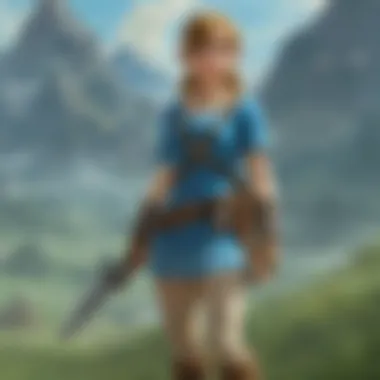
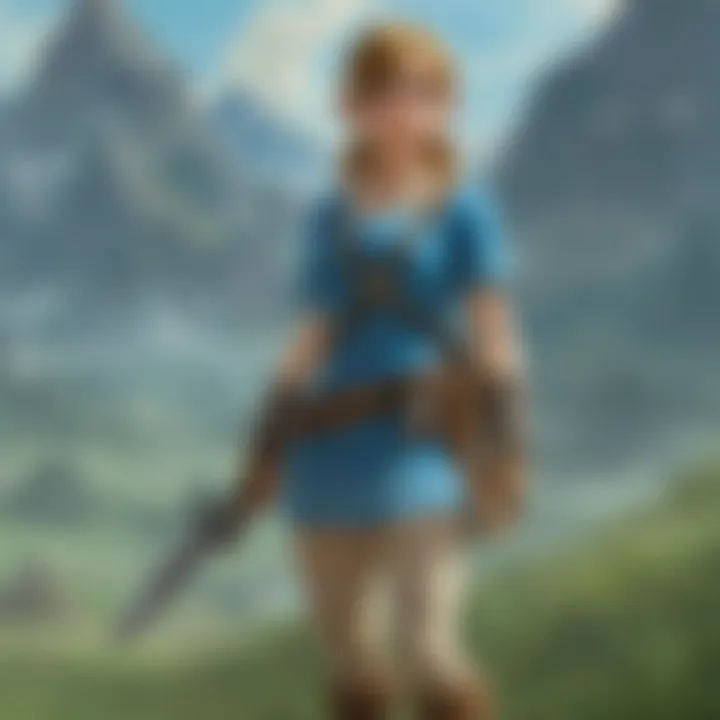
Mature Aesthetics
The box art for Twilight Princess takes a bold step into a more mature aesthetic, showcasing darker themes and a richly detailed visual style. This indicates a significant shift from the more whimsical tone of previous entries in the series, targeting an older gaming demographic.
The somber color palette and intricate details invite a different kind of emotional engagement, aligning well with the game’s departure toward deeper narratives. This choice amplifies the sense of foreboding that players will experience throughout the game. However, one misstep could be the potential alienation of younger players who may find this tone less appealing.
Narrative Elements in Design
The design of the Twilight Princess box art serves as a narrative in itself. Every element, from the design of Link and Zelda to the inclusion of the twilight motif, hints at the unfolding story of the game. The art suggests conflict, transformation, and the struggle between light and darkness — all core themes explored in this installment.
This intricate layering in design not only adds depth but also enriches the player's anticipation as they prepare to engage with the unfolding story. That said, the complexity might complicate the immediate recognition of the game’s lighter tones, drawing mixed reactions from a broad audience.
In essence, the box art of The Legend of Zelda series is not merely a visual presentation; it is a carefully constructed narrative that resonates deeply with fans, inviting them into a world crafted through artistic expression, cultural significance, and storytelling mastery.
The Artistic Process Behind Box Art
The creation of box art for The Legend of Zelda series is not merely an act of putting images on a cover; it is a meticulous artistic process that combines vision, marketing acumen, and collaboration. The outcome has a profound impact on fans' expectations and experiences. In a world where first impressions matter, the art in a box can significantly sway a potential buyer's decision.
From Concept to Completion
The journey from idea to finished product is intricate and layered. Initially, concepts for box art begin with brainstorming sessions where artists gather inspirations from various sources. They might dive deep into the game itself, extracting themes, and characters to embody in the artwork. It's a bit like cooking; you need to gather the right ingredients before you can whip up something delicious. The creative team balances the duality of giving an accurate representation of the game while also promising excitement and adventure to the audience.
Once the basic concepts are established, artists create rough sketches. These drafts serve as the foundation where compositions are tested and adjusted. Color schemes and visual styles are debated – it’s akin to choosing the right outfit for an important occasion. After numerous iterations, the design starts to take on a more refined form. The process can often feel like sculpting; each tweak and adjustment is a chisel, revealing the final piece from a block of stone.
After a design is agreed upon, it goes the route of digital refinement. Artists leverage tools and software that enable them to add depth and polish to the artwork, meticulously detailing every aspect to captivate audiences. With each pass, layers get added until the composition feels vivid and alive. Finally, once everything is in place, feedback loops ensure that the final product resonates not just with the designers but with marketing teams as well. This part is essential. Without public appeal, even the most aesthetically pleasing box art may flop.
Collaboration with Artists
The box art for The Legend of Zelda often reflects a blend of vision and effort from multiple talents. Various artists contribute their unique styles and insights, which fosters a rich tapestry of creativity. This collaborative environment encourages brainstorming, where diverse thoughts and techniques intermingle to produce standout visuals.
Often, the initial drafts come from illustrators who specialize in fantasy. Their experience allows them to capture the essence of Zelda's diverse universe. For instance, concepts around Link's iconic green tunic or Princess Zelda's ethereal presence involve artist interpretations that breathe life into the characters. Throughout this process, communication is paramount. Feedback between artists, artistic directors, and marketing teams ensures everyone stays on the same wavelength.
Collaboration doesn’t stop there. In a globalized world, input from different cultures can influence the design significantly. Variations in box art for different regions highlight distinct sensibilities, giving fans worldwide visual narratives that resonate with their respective contexts.
"An artist's only responsibility is to himself. He can be honest with himself about his art, and his art can be honest with others.”
— Walt Disney
This is particularly relevant in the case of Zelda, where each artwork has a narrative that transcends beyond visual appeal. It invites players into a world, linking character and story through art. This cohesive collaboration exemplifies how artists collectively shape the cultural landscape of a beloved franchise, leaving indelible marks on gaming history.
Fan Reception and Interpretation
The box art of The Legend of Zelda series is more than just a visual face for each game; it serves as an essential thread in the intricate tapestry of fandom that surrounds the franchise. This section delves into how fans interact with and interpret these artworks, providing a window into its broader cultural significance. The connection between fan reception and box art can enhance the understanding of how art becomes a part of storytelling and engagement with the series. The immediate response a cover generates can turn casual observers into dedicated players, reflecting its potent role as both a promotional tool and an emotional catalyst.
The Role of Fans in Art Commentary
Fans of The Legend of Zelda are known for their distinct and passionate perspectives on the franchise's box art. Through forums and social media platforms, discussions unfold about every brush stroke and color choice made by the artists. Let's examine what makes such commentary important:
- Critical Analysis: Fans aren't just consumers; they dissect the meaning behind each design. A discussion post might compare the youthful exuberance of The Legend of Zelda (1986) with the more somber tones of Twilight Princess (2006), analyzing how they reflect their respective eras in gaming.
- Cultural Context: Many fans place the art within a cultural framework. They might reference Japanese and Western influences impacting the designs, offering insights that enhance collective understanding. When the box art touches on folklore elements, fans highlight connections to real-world mythology, deepening appreciation.
- Community Building: Through commentary, fans cultivate a sense of community. Creating art critiques or fan-made analyses promotes dialogue and mutual respect, fostering a shared investment in the franchise.
In essence, fans elevate box art discussions beyond surface-level observations. They transform it into a lively discourse that informs not only their views but also the broader community’s appreciation of The Legend of Zelda.
Creating a Shared Visual Language
Shared visual language among fans of The Legend of Zelda emerges through a collective interpretation of box art that transcends different generations and experiences. This language forms a bond among players, emphasizing certain elements that resonate profoundly with the fan base:
- Iconic Symbols: For instance, the Triforce is not just a symbol on the cover; it embodies the very essence of the series’ themes—courage, wisdom, and power. When fans see it, nostalgia floods back as they reflect on various gameplay moments.
- Stylistic Choices: From the bright hues of early titles to the dark, moody palettes of genres like action-adventure and RPG, fans articulate their feelings about how these choices connect with the games’ narratives. This can lead to discussions not only about aesthetics but about emotional engagement as well.
- The Democratization of Art Appreciation: The broad reach of platforms like Reddit and Facebook has democratized art interpretation. Now, rather than a lone critic's voice, every fan's perspective shapes the collective understanding of the box art. This mixture of opinions reflects the diverse backgrounds and tastes of the audience, leading to richer interpretations.
By creating a shared visual language, fans establish connections that breathe life into the box art of The Legend of Zelda. Their interpretation resonates down through the ages, uniting enthusiasts in a celebration of an artistic journey that has changed and evolved with the times.
Comparative Analysis of Box Art
Understanding the differences between Western and Japanese box art provides insightful perspectives on how cultural contexts shape artistic expression. This comparative analysis reveals not just aesthetic preferences but also marketing strategies that cater to diverse audiences. The box art of The Legend of Zelda is more than a mere cover; it is a visceral narrative that begins even before the game is played. The visual representation reflects the ethos that each region hopes to convey to its players by tapping into their collective imagination.
Western vs. Japanese Designs
The disparity between Western and Japanese box art for The Legend of Zelda series embodies a broader storytelling approach. Japanese covers tend to be steeped in rich symbolism and detailed illustrations. They often embrace a fantastic style that aligns with the intricate narratives and themes of adventure within the game. For instance, The Legend of Zelda: Ocarina of Time features a beautifully illustrated Link wielding his signature sword against a backdrop of Hyrule's sprawling landscapes. This depiction instills a sense of epic quest and profound fantasy.
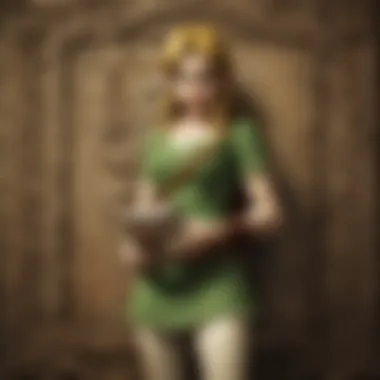
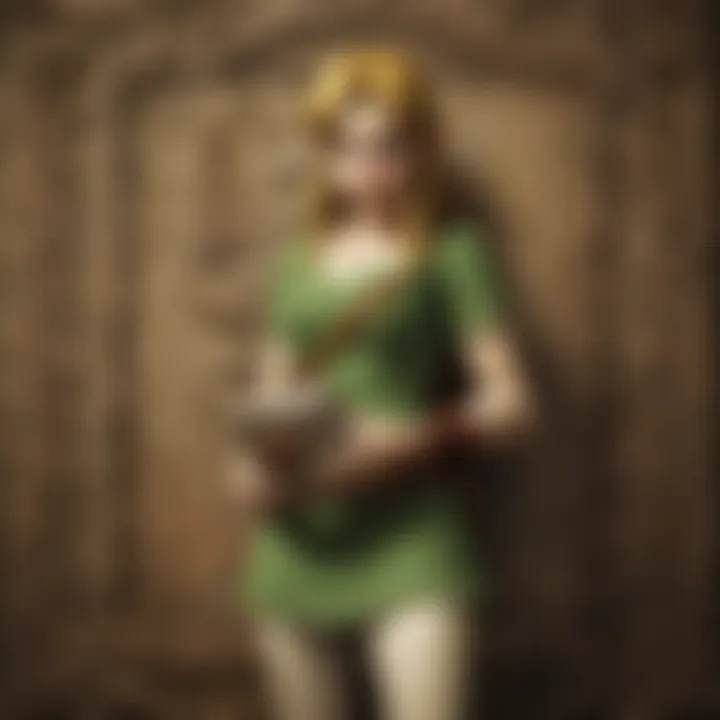
In contrast, Western designs generally prioritize a minimalist approach, focusing on recognizable elements to provide immediate visual cues. The cover of Twilight Princess, for example, prominently showcases Link in wolf form, a striking image that draws potential players in with its strong, bold aesthetic. This simplicity often aligns with Western marketing strategies, which value instant recognition over detailed storytelling.
"Art not only reflects culture but shapes it, presenting familiar symbols that resonate with an audience's values and expectations."
Through these strategic artistic choices, marketers aim to amplify appeal in each respective region. The sense of adventure may be universal, but the way it’s portrayed can pivot sharply based on cultural perspectives.
Shifts in Marketing Strategies
As the gaming industry evolved, so did the marketing strategies accompanying box art for franchises like The Legend of Zelda. Earlier designs often leaned heavily on the emerging graphical capabilities of consoles, showcasing artistic prowess that appealed to fans eager for eye-catching visuals. However, in the digital age, where instant access to information and visual contents is at people’s fingertips, the approach shifted to include more detailed narratives crammed into a single image.
In recent years, box art has begun to reflect online cultures more than ever before, aiming to grab attention on digital storefronts. This shift prompts the need for clarity and impact over complex artistry—to make an immediate impression on a small thumbnail in a digital marketplace. The art for Breath of the Wild, for instance, presents a bold character design set against the expansive world of Hyrule, a direct appeal to the player's sense of exploration and adventure.
Box Art in the Digital Age
As the gaming industry embraces the digital realm, the concept of box art is rapidly evolving. The days when a vibrant cover could speak volumes about a game, enticing players from store shelves, are transforming. In this digital age, box art still possesses significant relevance, acting more as a visual representation than a physical casing. As players download games instead of purchasing physical copies, the art shifts from simply being a packaging element to a key marketing touchpoint that represents the game's identity.
Transition to Digital Platforms
The transition from physical to digital platforms has fundamentally altered how video games are marketed and experienced. Gone are the times when a player could stroll through a game store, scanning the shelves for eye-catching covers. Now, games are predominantly sold through online platforms like Nintendo eShop, Steam, or PlayStation Network. Within these virtual marketplaces, box art has taken on a new role— it needs to stand out among a sea of thumbnails, often reduced to a thumbnail image on a screen.
Implications of Digital Marketing
- Visual Hierarchy: Online storefronts often prioritize visuals. Eye-catching designs now maximize visibility on first impressions, leading to a possible purchase.
- Animation and Interactivity: Unlike static physical covers, digital arts have opportunities for animation or interactive elements, potentially offering a more immersive experience.
- Dynamic Updates: Developers can modify box art post-launch to reflect updates, seasonal events, or to create buzz before expansions, keeping the representation fresh.
Players might underestimate the value of this digital art, but it plays a crucial role, connectng fans with the game's atmosphere even before they hit 'download'.
New Opportunities for Artistic Expression
With evolving technology, the possibilities for artistic expression through box art become increasingly diverse. Digital art allows for greater experimentation, as artists are not constrained by printing techniques or physical material costs. This freedom fosters creativity, leading to innovative designs that resonate with audiences.
- High-Resolution Graphics: Artists can produce stunning illustrations, unbound by the limitations of print. This quality can immerse gamers visually before they even start the game.
- Collaboration Across Platforms: The ability to collaborate online with artists and developers around the globe inspires unique styles, marrying various design philosophies into a cohesive piece.
- User Customization: Players can have some input on their box art through platforms that allow for remixes or fan art showcases, creating a sense of community and ownership over the art.
"In the digital realm, art becomes not just a facade but a canvas for continuous evolution, mirroring the shifts in gaming culture itself."
Artistry in the digital age speaks volumes, where engagement surpasses the traditional visual representation, translating feelings and themes into accessible formats. As The Legend of Zelda series moves forward, the box art reflects this transformation, marking new milestones of creativity and connection with players.
The Future of Box Art in The Legend of Zelda
As we gaze towards the horizon of The Legend of Zelda series, one might ponder the evolving nature of its box art. The visual aspect of these game covers has been a substantial part of the franchise's identity. Not only do these illustrations serve as a marketing gimmick to catch the eyes of potential players, but they also encapsulate the essence of the journey within each game. In a rapidly changing digital landscape, the importance of anticipating trends in graphic design and marketing strategies cannot be overstated. Let’s delve into some anticipated trends and the potential for innovation that may define the future of box art in this beloved series.
Anticipated Trends
Online platforms and social media change how art is viewed and shared. Therefore, box art designers are likely to harness these channels for greater reach. Future designs may lean more heavily on interactivity. Imagine a box art that expands when viewed through AR apps, transforming static images into dynamic experiences. Such innovations would surpass mere aesthetics, merging artistry with technology to captivate a technologically sophisticated audience.
Another trend could be the emergence of inclusive designs that better represent diverse experiences. The richness of Zelda's narratives often revolves around universal themes—courage, friendship, and growth. As society continues to strive for broader representation, box art may reflect this shift through varied character portrayals or by inviting input from a wider range of creators. The voice of the community could serve not only as inspiration but also as a guiding factor for future designs.
Potential for Innovation
The digital realm has opened doors to new modes of artistic expression, and box art within The Legend of Zelda franchise is not exempt from this evolution. With tools like generative art software and advanced animation techniques, designers can explore previously uncharted territories. Box art may evolve into a living entity that adjusts to player interactions, presenting different visuals based on the time of day or specific user preferences. This would diversify the user experience, allowing for personal connections to the artwork.
Moreover, the collaboration between gaming companies and independent artists might flourish. This trend could lead to bespoke covers crafted by fresh talent, each introducing their unique style to the franchise's fabric. By ensuring that these designs remain current and relevant, the Zelda series can maintain a connection with both longtime fans and a new generation of gamers.
"The potential for innovation in gaming art lies not just in aesthetics, but in how it interacts with the player’s world."
In essence, the future of box art in The Legend of Zelda is bright with promise. With anticipation mounting around technological advances and innovative collaborations, one can only wonder how the art that once adorned shelves will soon transform into immersive experiences that enhance the very narrative depth that the franchise is known for.
Epilogue
The significance of box art in The Legend of Zelda series cannot be overstated. It acts as a bridge between the game's concept and the player's imagination, encapsulating intricate narratives within a singular image. Each box conveys layers of meaning and emotion that set the stage even before a player inputs the game. It’s not just mere decoration; it’s a lens into the world that players are about to step into.
Reflections on the Role of Art
Artistry in box design evolves, reflecting both the zeitgeist of the gaming industry and cultural aspirations. Box art transforms simple packaging into profound storytelling. For instance, take The Legend of Zelda: Breath of the Wild. Its art presents an expansive landscape, beckoning the player to explore a vast, beautiful world. Such imagery speaks not just of the game's objectives, but of its ethos—curiosity, discovery, and adventure. Artistic choices—like color, form, and symbolism—offer an immediate emotional response. As a player, seeing Link wielding the Master Sword in Jeromos's captivating design stirs excitement; it draws one into a tale of epic scale.
Legacy of Box Art in Gaming Culture
The legacy of box art extends far beyond nostalgia. It is embedded in the broader narrative of gaming itself. From iconic works that have become cultural touchstones to the innovative designs that continue to evolve, box art reflects the changing landscape of video games. In the world of Zelda, each box has not only advertised a game but has also become a collector's item in its own right. Enthusiasts frequently exchange interpretations and scrutinize details, further perpetuating the conversation around the impact of visual art in gaming.
"Good box art is like a good book cover: it tempts you to explore the pages within."
As the industry progresses into an increasingly digital landscape, the importance of captivating art remains integral. Designs will continue to capture attention, just as they have done for decades, solidifying their status as essential aspects of the gaming experience and cementing their place within the fabric of gaming culture.







